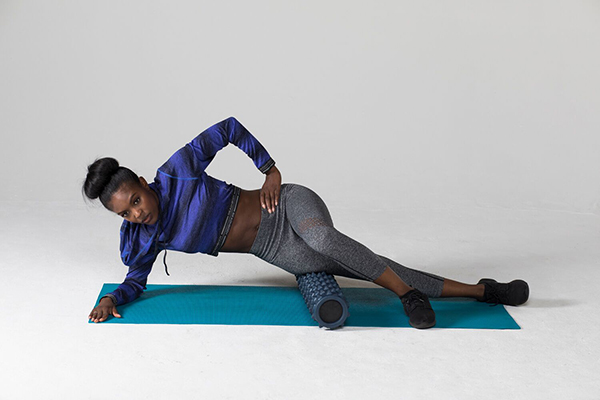Sore muscles are common after a tough workout, but when you’re really feeling the burn, you may wonder if you’re dealing with the usual muscle soreness — or if you actually have a pulled muscle or muscle strain.
Here’s how to tell the difference and how to recover.
What Is a Muscle Strain, or Pulled Muscle?
“Pulled muscles occur when a tensile force tears the muscle fibers, causing trauma,” explains Cody Braun, NASM performance enhancement specialist.
A muscle strain, or pulled muscle, constitutes damage beyond customary post-workout soreness, and most commonly affects the muscles in and around the calves and quadriceps.
“Muscle strains can be caused by a number of things, but overuse, overstretching, and fatigue are some of the main causes,” Braun adds.
The severity of a pulled muscle, or muscle strain, is graded on a scale from 1 to 3:
- Grade 1 strain: The mildest form of strain, involving a nominal number of fibers and costing little to no loss in strength.
- Recovery time: With proper care (see below), a muscle pull of this severity can heal within a few weeks.
- Grade 2 strain: A strain of moderate severity involving damage to more muscle fibers and a substantial loss of strength.
- Recovery time: Rehab can last from three to six weeks with appropriate treatment.
- Grade 3 strain: Complete tear of the muscle involving total loss of function that can require surgery to repair.
- Recovery time: A strain of this severity can take three to six months or more to rehabilitate.
Do You Have a Pulled Muscle or Is It Just Sore?
Registering far lower on the tissue-damage scale, delayed-onset muscle soreness (DOMS) occurs when there are microscopic tears within the muscle fibers.
“When a muscle is loaded during exercise, the fibers sustain microtears,” says Robert Herbst, a personal trainer, wellness coach, and World Champion powerlifter. “Over the next 48 to 72 hours, the body repairs the muscle and — through a process known as supercompensation — builds additional muscle in anticipation of greater loads in the future.”
As your body attempts to heal these microtears in the muscle fibers, it can cause mild swelling, which can lead to stiffness and soreness.
This kind of muscle soreness is common, and it’s usually evidence that you used new muscles groups, used them in a new way, or increased your intensity.
But it isn’t a workout badge of honor you need to aim for. When it comes to gauging the effectiveness of your workouts, seeing progress is more important than feeling soreness.
What Does a Pulled Muscle Feel Like?
“Differentiating between muscle soreness and a pulled muscle can be difficult if you don’t know what to look for,” explains Alex Tauberg, a board-certified sports chiropractor at Tauberg Chiropractic & Rehabilitation in Pittsburgh, Pennsylvania.
With both delayed-onset muscle soreness and a pulled muscle, the muscle may be warm to the touch, inflamed, swollen, and tender.
So how do you know if you have a pulled muscle? There are two key distinctions between DOMS and a pulled muscle:
- When you feel the discomfort
- The intensity of the discomfort
“With delayed-onset muscle soreness, there should not be much — if any — pain experienced during the workout,” Tauberg says. Instead, the soreness sets in a day or two later, and you may feel achy even when you’re not using those muscles.
The pain from a pulled muscle is typically more immediate and intense. “When you pull a muscle, you will often feel immediate, sharp pain,” Tauberg says. This may also lead to limited range of motion and muscle weakness during your workout.
The soreness from a pulled muscle is often more localized as well, says Braun. If you can pinpoint one particular spot that hurts — as opposed to an overall achy feeling — you may be dealing with a pulled muscle.
Muscle Strain Treatment and Self-Care at Home
If you think you may be suffering from more than just post-workout muscle soreness, it’s best to get the injury checked out.
“A pulled muscle should be looked at by a medical professional to rule out any possible concerns of a more severe injury,” Braun says. “Stretching a muscle strain can further the tears, so it’s wise to limit the stretching until other measures are taken.”
While you wait for an appointment, use the recovery method known as the POLICE protocol: protection, optimal loading, ice, compression, and elevation.
“You want to protect the area from further injury,” Tauberg says. “At the same time, you want to keep the area mobile without further exacerbating the injury. Following this protocol within the first 72 hours after suffering a muscle pull should set you up to recover from the injury.”
Once you’ve been given the all-clear to start exercising again, don’t jump right back in where you left off. Start slowly and gently, suggests Herbst, using high-rep workouts with lighter weights to increase blood flow to the area and start to rebuild strength.
What Can I Do After a Workout to Help With Muscle Soreness?
Even if you’re just suffering from standard muscle soreness, there are steps you can take to relieve your discomfort. Braun suggests the following:
- Apply hot or cold treatments.
- Emphasize nutritional strategies that can decrease DOMS and help with muscle recovery.
- Try out compression garments, which research suggests can help prevent DOMS.
- Work foam rolling into your recovery regimen, also found through study to reduce DOMS.
- Get a massage, which has been shown to reduce the intensity of post-workout soreness.


